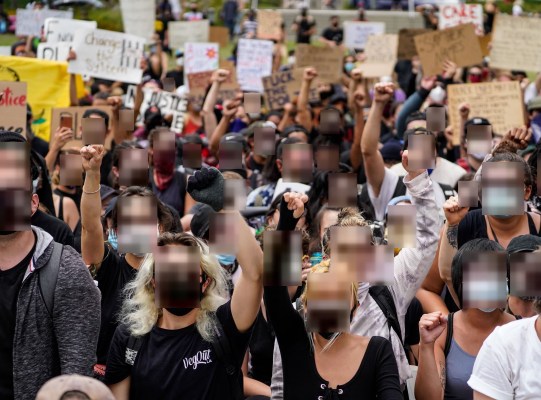Millions have taken to the streets across the world to protest the murder of George Floyd, an unarmed Black man killed by a white police officer in Minneapolis last month.
Protesters have faced both unprecedented police violence and surveillance. Just this week, the Justice Department granted the Drug Enforcement Administration, an agency typically tasked with enforcing federal drug-related laws, the authority to “conduct covert surveillance” on civilians as part of the government’s efforts to quell the protests. As one of the most tech-savvy government agencies, it has access to billions of domestic phone records, cell site simulators, and, like many other federal agencies, facial recognition technology.
It’s in part because of this intense surveillance that protesters fear they could face retaliation.
But in the past week, developers have rushed to build apps and tools that let protesters scrub hidden metadata from their photos, and mask or blur faces to prevent facial recognition systems from identifying protesters.
Everest Pipkin built a web app that strips images of their metadata and lets users blur faces — or mask faces completely, making it more difficult for neural networks to reverse blurring. The web app runs entirely in the browser and doesn’t upload or store any data. They also open-sourced the code, allowing anyone to download and run the app on their own offline device.
Pipkin is one of a few developers who have rushed to help protesters protect their privacy.
“I saw a bunch of discourse about how law enforcement is aggregating videos of the protests from social media to identify protesters,” developer Sam Loeschen told TechCrunch. He built censr, an augmented reality app that works on the iPhone XR and later, which masks and pixelates photos in real-time.
The app also scrubs images of metadata, making it more difficult to identify the source and the location of the masked image. Loeschen said it was a “really easy weekend project.” It’s currently in beta.
Noah Conk built an iPhone Shortcut that uses Amazon’s facial recognition system and automatically blurs any faces it detects. Conk said in a tweet there was no way to blur images on the device but that he does not save the image.
The idea is smart, but it does mean any photos uploaded could theoretically (and if stored) be obtained by law enforcement with a legal order. You also need to “allow untrusted shortcuts”, which could open the door to potentially malicious shortcuts. Know the risks before allowing untrusted shortcuts, and keep it disabled when you don’t need it.
Helping protesters and others blur and anonymize photos is an idea that’s taking off.
Just this week, end-to-end encrypted messaging app Signal included its own photo blurring feature, one that couldn’t come soon enough as its user base spiked thanks to the massive adoption since the protests started.
Signal founder Moxie Marlinspike said in a blog post that the move was to help “support everyone in the streets,” including those protesting in the U.S. and around the world, in many cases defying social distancing rules by governments put in place to slow the spread of the coronavirus pandemic.
“One immediate thing seems clear: 2020 is a pretty good year to cover your face,” said Marlinspike.
